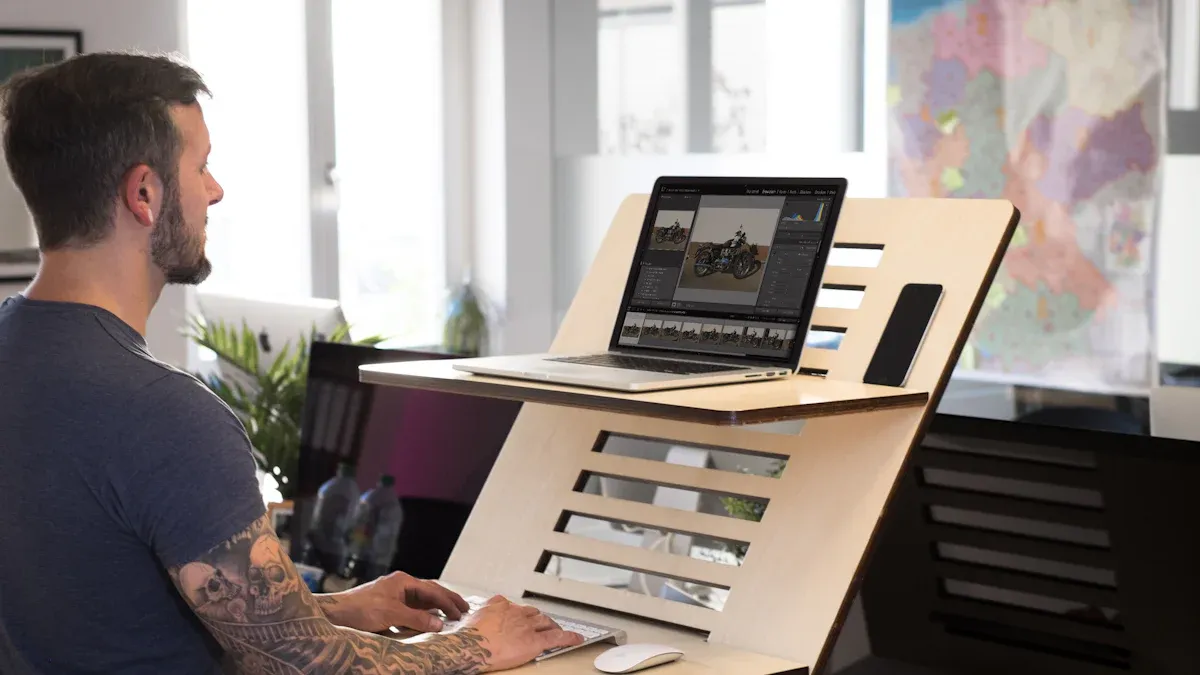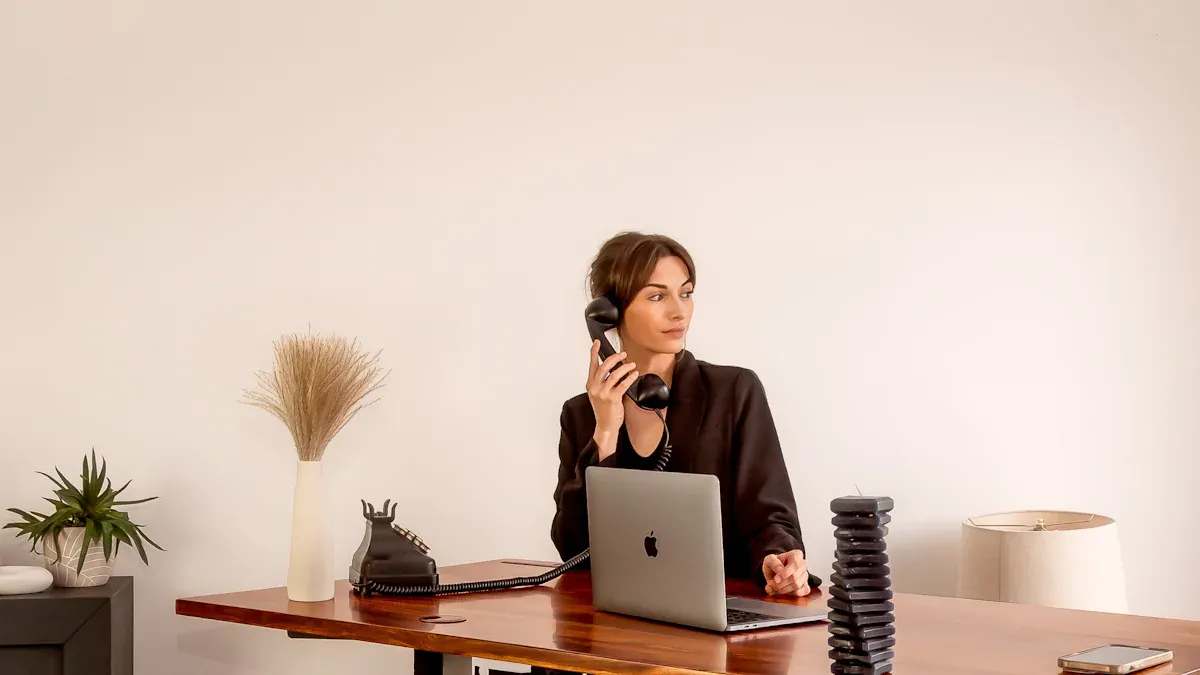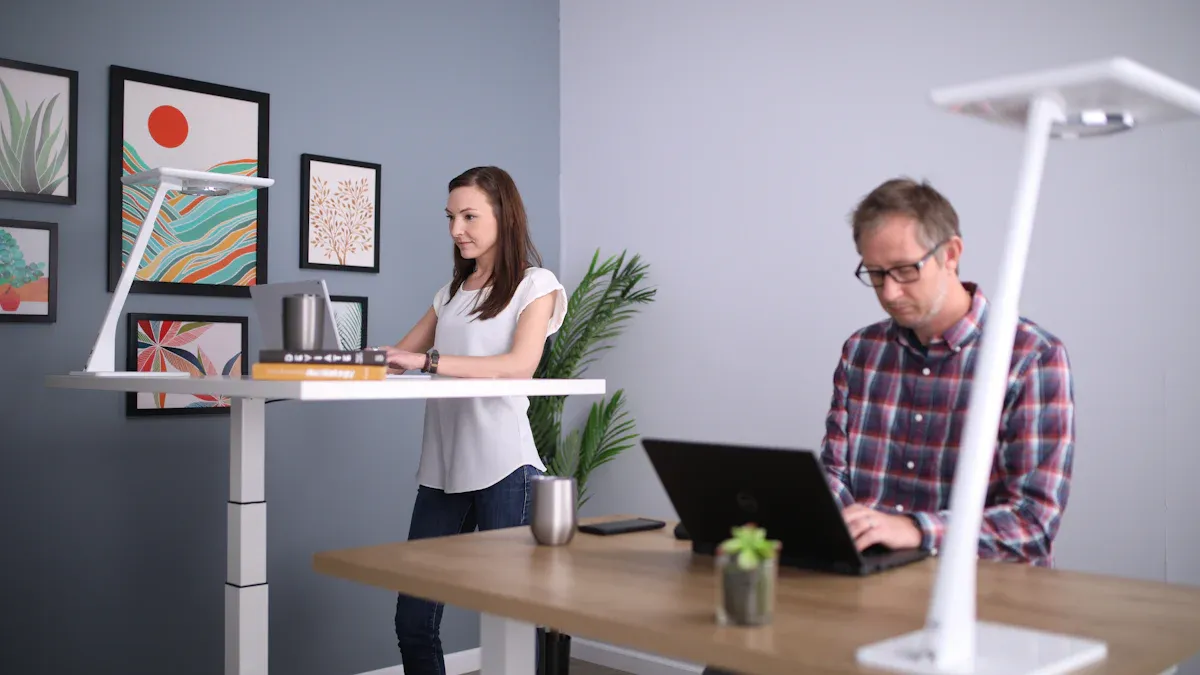
You might wonder if an adjustable desk can really help with back pain. Studies show that using a Height Adjustable Standing Desk may ease some back discomfort, especially if you switch positions often. You need to use your desk the right way to get the most out of it. Some people find that Double Column Height Adjustable Desks give even more support for posture. Everyone’s body reacts differently, so you should listen to your own needs.
Key Takeaways
- Using a height adjustable desk helps reduce back pain by letting you switch between sitting and standing.
- Good posture and proper desk setup are essential to get the most benefit and avoid new pain.
- Standing too long can cause leg or foot discomfort, so change positions often and listen to your body.
- Small movements like stretching and walking during the day keep your back flexible and reduce stiffness.
- An adjustable desk works best with healthy habits like good posture, regular breaks, and staying hydrated.
Why Adjustable Desk Use Matters for Back Pain
Common Causes of Back Pain from Desk Work
You might not notice it at first, but sitting at your desk for hours can hurt your back. Many people slouch or lean forward when they work on a computer. This puts extra pressure on your spine and muscles. Sometimes, your chair or desk does not fit your body well. If your screen sits too low or your chair does not support your lower back, you may feel pain by the end of the day.
Here are some common reasons you might get back pain at your desk:
- Poor posture, like slumping or hunching over
- A chair that does not support your back
- A desk that is too high or too low
- Reaching too far for your keyboard or mouse
Tip: Try to keep your feet flat on the floor and your back straight. This helps your spine stay in a healthy position.
The Role of Prolonged Sitting
Sitting for long periods can make your back feel stiff and sore. When you sit too much, your muscles get tight and weak. Blood does not flow as well, so your body does not get the oxygen it needs. Over time, this can lead to more pain and even long-term problems.
An adjustable desk lets you change your position during the day. You can stand up for a while, then sit down when you need a break. This helps you move more and keeps your back from getting tired. You do not have to stand all day, but switching between sitting and standing can make a big difference.
Scientific Evidence on Adjustable Desks and Back Pain
Research Findings on Pain Relief and Prevention
You probably want to know if science backs up the idea that an adjustable desk can help your back. Good news—many studies say yes! Researchers have looked at people who use adjustable desks at work. They found that switching between sitting and standing can lower back pain for many people.
One study from 2018 followed office workers for several months. The group that used adjustable desks reported less back pain than those who sat all day. Some people even said their pain went away after a few weeks. Another study showed that standing for short periods helped people feel less tired and more focused.
Note: Not everyone gets the same results. Some people feel better right away, while others need more time to adjust. You might need to try different ways of using your desk to see what works best for you.
Here are some things researchers noticed:
- People who stand and sit during the day feel less back and neck pain.
- Workers move more when they use an adjustable desk.
- Some people feel more energy and less stress.
Benefits and Limitations of Adjustable Desks
You can get many benefits from using an adjustable desk, but it is not a magic fix for everyone. Let’s look at what you can expect.
Benefits:
- You can change your position easily. This helps your back and keeps your muscles from getting stiff.
- You may feel less pain in your lower back and neck.
- You might find it easier to focus and stay alert.
Limitations:
- Standing too long can make your legs and feet hurt.
- If you do not set up your desk the right way, you might still have pain.
- Some people need time to get used to standing more during the day.
| Benefit | Limitation |
|---|---|
| Less back pain | Possible leg or foot discomfort |
| More movement | Need for proper desk setup |
| Better focus | Takes time to adjust |
Tip: Try to listen to your body. If you feel tired or sore, take a break or change your position.
You should remember that an adjustable desk works best when you use it with good habits. Move around, stretch, and pay attention to how you feel. This way, you can get the most out of your desk and help your back feel better.
How an Adjustable Desk Can Help Your Back

Improving Posture and Spinal Alignment
You might notice your shoulders rounding or your neck sticking out when you sit for a long time. An adjustable desk lets you set your workspace at the right height. This helps you keep your back straight and your head up. When you stand, you can line up your ears, shoulders, and hips. Good posture takes pressure off your spine. You may feel less pain in your lower back and neck.
Try this: Stand tall with your shoulders relaxed. Keep your screen at eye level. Your body will thank you!
Reducing Spinal Compression
Sitting puts a lot of weight on your lower back. Over time, this can squeeze your spine and cause pain. When you use an adjustable desk, you can stand up and take the load off your back. Standing helps your spine stretch out. You give your back a break from all that pressure. You might feel lighter and more comfortable after just a few minutes.
Here’s a quick look at how sitting and standing affect your spine:
| Position | Spinal Pressure | How You Might Feel |
|---|---|---|
| Sitting | High | Stiff, sore, tired |
| Standing | Lower | Relaxed, less pain |
Encouraging Movement and Flexibility
Your body likes to move. Staying in one spot for too long makes your muscles tight. An adjustable desk helps you switch between sitting and standing. You can stretch, walk in place, or shift your weight. These small moves keep your back flexible. You may even feel more awake and focused.
- Stand for a few minutes every hour.
- Stretch your arms and legs.
- Take short walks around your room.
Remember: Little movements add up. Your back will feel better when you keep it moving!
Drawbacks and Challenges of Adjustable Desk Use
Risks of Prolonged Standing
Standing sounds healthy, but too much of it can cause problems. If you stand for hours without a break, your legs might feel tired or sore. You could get pain in your feet or knees. Sometimes, your lower back starts to ache. Your blood might not flow as well, and your ankles could swell. You might even feel dizzy if you stand too long without moving.
Tip: Try to stand for short periods. Sit down when your body feels tired. Listen to what your legs and back tell you.
Importance of Ergonomic Setup
You need to set up your workspace the right way. If your desk or monitor sits too high or too low, you might strain your neck or shoulders. Your chair should support your lower back. Your keyboard and mouse should be easy to reach. If you skip these steps, you may still feel pain, even if you switch between sitting and standing.
Here’s a quick checklist for a good setup:
- Keep your screen at eye level.
- Place your keyboard and mouse close to you.
- Use a chair with good back support.
- Stand on a soft mat if possible.
Note: A good setup helps you feel comfortable and keeps your body safe.
Common Mistakes to Avoid
Many people make simple mistakes when they start using a new desk. You might stand for too long at first. You could forget to move or stretch. Sometimes, you set your desk at the wrong height. You may ignore pain or discomfort, hoping it will go away.
Here are some mistakes to watch out for:
- Standing all day without breaks.
- Slouching or leaning on one leg.
- Placing your monitor too low.
- Forgetting to stretch or walk.
Remember: Small changes make a big difference. Pay attention to your body and adjust your habits as needed.
Best Practices for Using an Adjustable Desk

Setting Up Your Desk for Comfort
You want your workspace to feel good every day. Start by making sure your monitor sits at eye level. This helps you keep your neck straight. Place your keyboard and mouse close to your body. Your elbows should bend at about 90 degrees. If you use a chair, pick one that supports your lower back. Stand on a soft mat if you plan to stand for a while. This can help your feet feel better.
Here’s a quick setup checklist:
- Monitor at eye level
- Keyboard and mouse close to you
- Chair with back support
- Feet flat on the floor or on a mat
Tip: Take a moment each morning to check your setup. Small changes can make a big difference.
Tips for Switching Between Sitting and Standing
Switching positions helps your body stay happy. Try not to stand or sit for too long. You can start by standing for 15 to 30 minutes every hour. Use a timer or an app to remind you. If you feel tired, sit down and rest. Move your feet and shift your weight when you stand. This keeps your blood flowing.
A simple routine might look like this:
| Time (minutes) | Position |
|---|---|
| 0-30 | Sitting |
| 30-45 | Standing |
| 45-60 | Sitting |
Remember: Listen to your body. If you feel sore, change your position.
Additional Strategies for Back Health
An adjustable desk helps, but you can do more for your back. Stretch your arms, legs, and back during the day. Take short walks, even if it’s just around your room. Drink water to keep your muscles healthy. Try to keep good posture, whether you sit or stand. If you feel pain, talk to a doctor or a physical therapist.
Here are some extra tips:
- Stretch every hour
- Walk during breaks
- Stay hydrated
- Watch your posture
Your back will thank you for these healthy habits!
Who Benefits Most from an Adjustable Desk
Identifying Ideal Users
You might wonder if you are the right person for an adjustable desk. Many people can benefit from using one, but some groups see the biggest changes. If you spend hours at a computer, you may notice back pain or stiffness. Office workers, students, and gamers often sit for long periods. You might also have a job that lets you work from home. If you want to move more during your day, an adjustable desk can help.
Here are some signs you might be an ideal user:
- You feel sore or tired after sitting.
- You want to stand up and stretch more.
- You care about your posture.
- You work at a desk for most of the day.
If you like to change positions and keep your body moving, you will probably enjoy using an adjustable desk.
When an Adjustable Desk May Not Be Enough
Sometimes, an adjustable desk does not solve every problem. You may have back pain from an injury or a medical condition. In these cases, you should talk to a doctor before making changes. Some people need extra support, like special chairs or physical therapy. If you do not set up your desk the right way, you might still feel pain.
Here is a quick table to help you decide:
| Situation | Will a Desk Help? |
|---|---|
| Mild back pain from sitting | Likely |
| Chronic pain or injury | Ask your doctor |
| Poor posture habits | Yes, with good setup |
| Need to move more during work | Yes |
Remember: An adjustable desk works best when you use it with other healthy habits. Stretch, walk, and listen to your body.
You can find real relief from back pain when you use an adjustable desk the right way. This tool lets you move more and helps your posture. Remember, everyone’s body is different. Try these steps:
- Listen to your body.
- Set up your workspace for comfort.
- Ask a doctor if pain does not go away.
Your health matters most. Make choices that fit your needs.
FAQ
Can you use a height adjustable desk all day?
You can, but it’s best to switch between sitting and standing. Try standing for 15–30 minutes every hour. Your body needs breaks. Listen to how you feel and change positions when you get tired.
Do you need special shoes or mats for standing?
Standing mats or comfy shoes help your feet feel better. Hard floors can make your legs sore. A soft mat gives you more support. You don’t need fancy gear, but a little cushion goes a long way.
Will a height adjustable desk fix all back pain?
A desk helps many people, but it’s not a cure-all. You might still need to stretch, move, or see a doctor. If pain sticks around, talk to a professional.
How do you know if your desk is at the right height?
Check your elbows. They should bend at about 90 degrees when you type. Your screen should sit at eye level. If you feel sore, adjust your setup.
Tip: If you feel pain, try changing your desk height or your chair. Small tweaks can make a big difference!
Post time: Jun-24-2025
